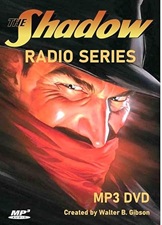
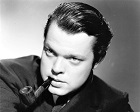 Who knows what evil lurks in the hearts of men?
Who knows what evil lurks in the hearts of men?
The Shadow knows!
The Shadow (1937-1954) aired “The League of Terror” on January 9, 1938. Though only 278 episodes are known to still exist out of over 800 (depending on how one counts), the number is subject to change as new episodes are unearthed from time to time. Out of the just over three dozen episodes of The Shadow we’ve run since 2009, this is only the second since April of 2023 and the first since November of 2024, almost a year ago, so I felt it was time for another, for The Shadow has proven quite popular with Golden Age radio fans, and especially fans of the Shadow in both radio and magazine formats.
The following is an abridged account of the character’s radio and magazine history for those coming to The Shadow for the first time. Long-time listeners may have forgotten some of the details, so if you are among them, refresh your memories or take a moment to grab your favorite beverage of choice before listening to this episode.
The history of the Shadow character is long and storied. A bare bones synopsis begins on July 3, 1930 when the narrator of magazine publisher Street & Smith’s radio version of its pulp magazine, Detective Story Magazine, was given the name of The Shadow. This mysterious voice who merely introduced and narrated the radio show, but was not a character in any of the episodes, became so popular after it was taken over by Frank Readick, Jr. and his spooky, phantom laugh that on April 1, 1931 The Shadow magazine was born. It ran for 325 issues, 282 of them written by Walter B. Gibson (1897-1985) under the house name of Maxwell Grant.
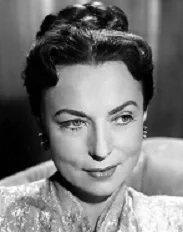 The Shadow debuted on radio on September 26, 1937 and delighted fans for more than seventeen years, closing shop on December 26, 1954. The radio show began its long run on the Mutual Broadcasting Network on Sunday evenings and was sponsored by Blue Coal. From its inception until just past its first year (Sept., 1937-Sept., 1938) the voice of the young 22-year-old Orson Welles (1915-1985) would be heard as that of the Shadow, and Agnes Moorehead (1900-1974, photo at left) would play the role of “the lovely Margot Lane,” his “faithful companion” and aide. Following Welles’s departure (“Professor X” was his final episode) Bill Johnstone (1908-1996) became the Shadow for the September 25th, 1938 episode, at the beginning of Season Two. He was then succeeded by Bret Morrison (1912-1978), who, in two stints (1943-44 & 1945-54), was radio’s the Shadow for ten of its seventeen years (though others besides these three mainstays would ascend to the role). Moorehead would also exit the show
The Shadow debuted on radio on September 26, 1937 and delighted fans for more than seventeen years, closing shop on December 26, 1954. The radio show began its long run on the Mutual Broadcasting Network on Sunday evenings and was sponsored by Blue Coal. From its inception until just past its first year (Sept., 1937-Sept., 1938) the voice of the young 22-year-old Orson Welles (1915-1985) would be heard as that of the Shadow, and Agnes Moorehead (1900-1974, photo at left) would play the role of “the lovely Margot Lane,” his “faithful companion” and aide. Following Welles’s departure (“Professor X” was his final episode) Bill Johnstone (1908-1996) became the Shadow for the September 25th, 1938 episode, at the beginning of Season Two. He was then succeeded by Bret Morrison (1912-1978), who, in two stints (1943-44 & 1945-54), was radio’s the Shadow for ten of its seventeen years (though others besides these three mainstays would ascend to the role). Moorehead would also exit the show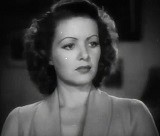 (in 1940) to follow Welles after he formed his Mercury Theater on the Air, as well as appear in several of the young genius’s classic films. That said, Moorehead would take a break (March to September of 1938) during the second season, at which time the more than capable Margot Stevenson (1912-2011, photo at right) would assume the role of Margot Lane.
(in 1940) to follow Welles after he formed his Mercury Theater on the Air, as well as appear in several of the young genius’s classic films. That said, Moorehead would take a break (March to September of 1938) during the second season, at which time the more than capable Margot Stevenson (1912-2011, photo at right) would assume the role of Margot Lane.
To arrest possible confusion arising from seeming inconsistencies between the print and radio versions of The Shadow it is important to note the following differences (though there are others):
The original print version of the Shadow portrayed him without any powers at all; he was a shadowy figure of the darkness, a cunning sleuth dedicated to overthrowing evil wherever he found it. It wasn’t until the radio version came along that he was imbued “with the power to cloud men’s minds” from a secret he learned in the Orient.
In The Shadow novels, Miss Lane’s first name was spelled Margo; for radio it was Margot.
In The Shadow novels, Margo Lane was not aware of the Shadow’s secret identity; for the radio scripts she was the only one who did know his secret identity.
In the magazine, the Shadow’s primary alter-ego was (eventually) revealed as that of Kent Allard; his radio alter-ego was Lamont Cranston.
“The League of Terror” begins with a small shop owner being sentenced to a year in prison for perjury. Lamont smells a rat and soon we discover that the beleaguered family man has been threatened by a crime ring to change his eyewitness testimony in a counterfeit money laundering scheme. The store owner has sworn under oath that the criminals filtered bad bucks through his mom and pop store, but now, at the trial, he has inexplicably changed his testimony, setting the crooks free, and it is he, the poor shop owner, who will spend time in the pokey for his perjury The Shadow learns the truth behind this old fashioned crime story, that it is yet another case of the bad guys making the good guy an offer it is almost impossible for him to refuse in order to protect his family. While this may seem a familiar, and not too exciting story, many of the Shadow’s most down to earth, relatable tales touch the listener more on a personal level than those exciting adventures where he battles evil geniuses or secret cults bent on destroying the city or the world. So take a few minutes and ask yourself what you would do to protect those you love (or even just yourself) in this well written and dramatically acted (by Orson Welles) radio drama when an honest man is put to the test when threatened by “The League of Terror.”
The weed of crime bears bitter fruit. Crime does not pay. –The Shadow
(The linked The Shadow Radio Series disc cover at top left is actually an MPG-DVD ROM. It contains all 278 existing The Shadow episodes with over 125 hours of listening time. Each episode is in its originally broadcast format, with no remastering or digitizing. When it comes to audio quality all episodes are serviceable though episodes from the ’40s and ’50s produce a noticeably cleaner sound.)
Play Time: 31:20
{“The League of Terror” aired on a late Sunday afternoon in early January of 1938, after the neighborhood gang had returned from the Christmas and New Year’s holidays and were still trying to accustom themselves to returning to the grind of a full school week the next day. Making it through a Monday that dragged on forever, they headed straight for the nearby newsstand to find which of their favorite magazines were waiting for someone to take them home. The newest issue of The Shadow magazine was unfortunately already sold out, but fortunately there were other favorites still on the shelves from which they could choose. Astounding Stories (1930-present, now Analog) was becoming a strong favorite, and this issue helped prove the appellation as one of the authors featured on the cover was (if you squint in the red box in the lower right corner of the cover) Don A. Stuart, a pseudonym for none other than the magazine’s new editor, John W. Campbell, Jr., who was handed the editorial reins from its former editor F. Orlin Tremaine in late 1937, and then fully became Astounding‘s editor with the issue featured below, the January 1938 issue. Obviously, the story by “Don A. Stuart” was bought by Tremaine while he was still editor. Astounding Stories (later Astounding Science Fiction along with a few other tweaks to the title over the years) was a monthly in 1938. Black Mask (1920-51) was the unopposed king of the detective pulps for several reasons, no doubt in large part for first serializing Dashiell Hammett’s now classic noir detective novel The Maltese Falcon in 5 parts, running from the September 1929 to the January 1930 issue. Black Mask was a monthly in 1938, though it did miss its July issue. Weird Tales (1923-54) was the much renowned supernatural horror pulp of all time, featuring nearly all of the many SF, Fantasy, and Horror writers in the field—even the SF and fantasy practitioners who showed their versatility by penning some of the genre’s most beloved and iconic horror tales. Some of the more recognizable names to grace “the unique magazine’s” pages include Robert Bloch, Henry Kuttner, Seabury Quinn (who pretty much made a living selling to WT), H. P. Lovecraft, Clark Ashton Smith, Jack Williamson, Robert E. Howard, Edmond Hamilton, Donald Wandrei, Manly Wade Wellman, Fritz Leiber, Frank Belknap Long, E. Hoffman Price, C. L. Moore, Ray Bradbury, and the list goes on and on. WT is one of the most sought after collector’s magazines in the huckster room at SF cons. Just one of many reasons were the luscious, gracefully posed semi-nude females on many of its covers from 1933-38, drawn by the inestimable WT cover artist, Margaret Brundage (1900-1976). Weird Tales was a monthly in 1938.}
[Left: Astounding Stories, 1/38 – Center: Black Mask, 1/38 – Right: Weird Tales, 1/38]
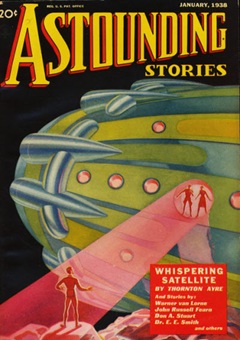
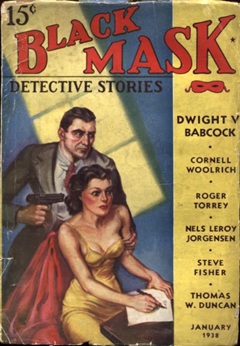
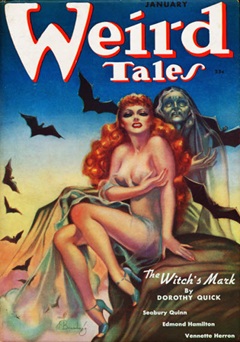
To view the entire list of weekly Old Time Radio episodes at Tangent Online, click here.